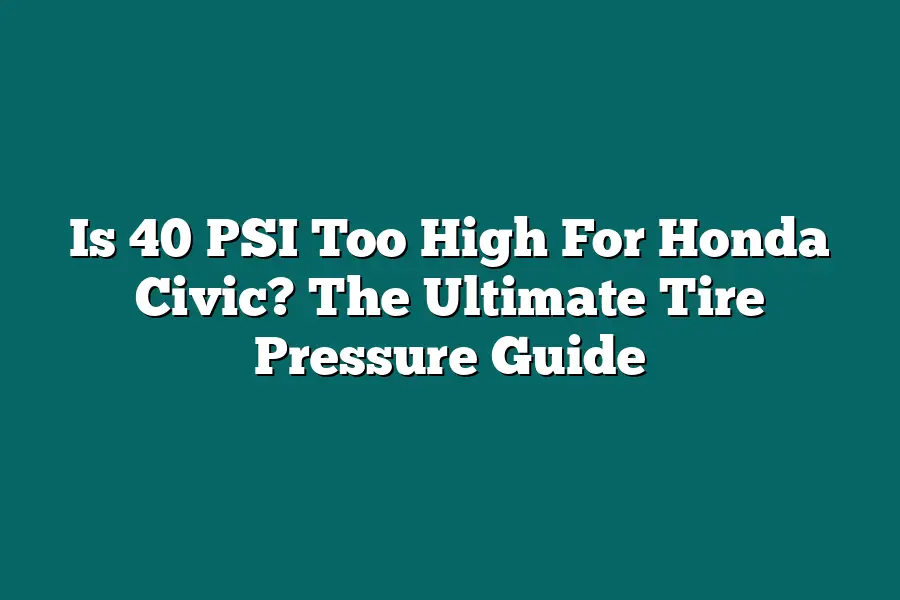The recommended tire pressure for a Honda Civic varies depending on the model and trim, but generally falls within the range of 32-38 psi. So, 40 psi might be considered slightly higher than recommended, although it ultimately depends on the specific vehicle and driving conditions. It’s always best to consult your owner’s manual or the manufacturer’s specifications for guidance on proper tire pressure.
As I slide behind the wheel of my trusty Honda Civic, I’m reminded that there’s more to this iconic ride than just its sleek design and impressive fuel efficiency.
One crucial aspect that often gets overlooked is tire pressure – a seemingly minor detail that can have a significant impact on my driving experience.
From improved handling to reduced wear on tire sidewalls, the right tire pressure can make all the difference.
But what’s considered “right” for my Honda Civic?
Is 40 PSI too high, or am I getting the most out of my tires?
In this ultimate guide, we’ll dive into the world of tire pressure, exploring the pros and cons of running 40 PSI on a Honda Civic, and provide actionable tips to help you achieve the perfect balance.
Table of Contents
Understanding Tire Pressure for Honda Civic
When it comes to your trusty Honda Civic, you want to make sure everything is just right – from the oil changes to the tire pressure.
But what’s the ideal tire pressure for your ride?
Is 40 PSI too high?
In this guide, we’ll dive into the world of tire pressure and help you understand why it matters so much.
What’s Tire Pressure Anyway?
Before we get into the nitty-gritty, let’s define what tire pressure is.
Simply put, tire pressure refers to the amount of air inside your tires.
It’s measured in pounds per square inch (PSI), and it plays a significant role in how your car handles, how much fuel you consume, and – most importantly – how safe you are on the road.
Fuel Efficiency: The Dark Horse
You might be surprised to learn that tire pressure has a direct impact on your fuel efficiency.
According to the United States Department of Energy, properly inflated tires can improve gas mileage by up to 3%.
That’s like saving $15 per year in fuel costs – not bad!
On the flip side, underinflated tires can decrease fuel efficiency and even lead to premature tire wear.
Handling: The Sweet Spot
When it comes to handling, tire pressure is crucial.
Underinflated tires can cause your car to wobble or vibrate more than usual, making it harder to steer – especially at high speeds.
On the other hand, overinflated tires can lead to reduced traction and a longer stopping distance.
The sweet spot?
A well-maintained tire pressure that’s just right.
Safety: The Lifeline
Tire pressure isn’t just about performance; it’s also a matter of safety.
Underinflated tires are more prone to blowouts, which can be disastrous on the highway.
In fact, according to the National Highway Traffic Safety Administration (NHTSA), tire-related crashes account for over 700 fatalities and 50,000 injuries each year in the United States alone.
Why Honda Recommends a Specific Range
Now that we’ve covered the basics, let’s talk about why Honda recommends a specific tire pressure range for your Civic.
The answer is simple: safety.
By sticking to the recommended range (32-38 PSI), you’re ensuring your tires are properly inflated and ready to handle whatever the road throws at them.
The Importance of Regular Checks
So, how do you know if your tire pressure is within the recommended range?
Simple: check it regularly!
You can use a trusty tire pressure gauge or consult your owner’s manual for guidance.
It’s also a good idea to adjust your tire pressure according to driving conditions – like switching from city driving to highway cruising.
There you have it – the ultimate guide to tire pressure for your Honda Civic.
By understanding why 40 PSI might be too high, and by keeping your tires properly inflated, you’ll be well on your way to a safer, more fuel-efficient ride.
Stay tuned for our next installment!
Is 40 PSI Too High for Honda Civic?
So, you’re wondering if running 40 PSI is too high for your trusty Honda Civic.
Well, you’ve come to the right place!
In this ultimate tire pressure guide, we’ll dive into the pros and cons of cranking up that air pressure.
The Pros: Increased Traction, Improved Handling, and Reduced Wear
Let’s start with the good stuff.
Running 40 PSI can provide:
- Increased traction: Higher air pressure means a more even tire-to-road interface, which translates to better grip on corners and improved acceleration.
- Improved handling: With a firmer tire, your Honda Civic will respond quicker to steering inputs, making it more agile and fun to drive.
- Reduced wear on tire sidewalls: Thicker tires are less prone to damage from curbs, potholes, or other hazards that can cause costly repairs.
The Cons: Decreased Fuel Efficiency, Potential Damage to Suspension Components, and Increased Risk of Tire Blowouts
But, there’s a catch (or three).
Running 40 PSI can also lead to:
- Decreased fuel efficiency: Higher air pressure creates more rolling resistance, which means your Civic will guzzle more gas. Ouch!
- Potential damage to suspension components: The increased stiffness from high tire pressure can put additional stress on your suspension, potentially leading to premature wear or even failure.
- Increased risk of tire blowouts: Tires that are too stiff or under-inflated can be more prone to blowouts, especially at higher speeds.
Scenarios Where 40 PSI Might Be Suitable
Now, I know what you’re thinking: “But wait, isn’t there a scenario where 40 PSI would be perfect?” Absolutely!
If you prioritize performance over fuel efficiency, and your Honda Civic is designed for aggressive driving (like a track car), then running 40 PSI might make sense.
However, if you’re looking to optimize fuel efficiency or drive on rough roads, you might want to consider a lower pressure.
In conclusion, whether 40 PSI is too high for your Honda Civic depends on your specific driving habits and preferences.
If you value performance over fuel efficiency, then cranking up the air pressure might be just what you need.
But if you’re looking for a balance between traction and fuel economy, you might want to experiment with lower pressures.
Stay safe, stay informed, and keep those tires properly inflated!
Adjusting Tire Pressure for Honda Civic: Tips and Best Practices
As I’m sure you’re aware, proper tire pressure is crucial for your Honda Civic’s overall performance and safety.
But did you know that over- or under-inflated tires can negatively impact your vehicle’s fuel efficiency, handling, and even longevity?
In this section, we’ll dive into the ultimate guide on how to adjust tire pressure correctly using a trusty tire pressure gauge.
Why Temperature Matters
Before we get started, it’s essential to understand that tire pressure affects more than just the tire itself.
Your Honda Civic’s engine, transmission, and even suspension can be impacted by incorrect pressures!
That’s why checking your tire pressure at room temperature is crucial.
Why?
Well, tire pressure naturally increases with heat, so if you check your pressure after driving or in a hot garage, you might be getting an inflated (pun intended) reading!
For optimal results, make sure to check your tire pressure when your tires are cold – preferably first thing in the morning or just before you start driving.
This ensures that you’re getting an accurate measurement.
Tips for Achieving the Optimal Tire Pressure Range
Now that we’ve covered why temperature matters, let’s talk about how to achieve the optimal tire pressure range for your Honda Civic.
According to Honda’s owner’s manual, the recommended tire pressure for most models is between 35-40 PSI (pounds per square inch).
However, this might vary depending on the specific trim level and wheel size.
Here are some tips to help you find the sweet spot:
- Consult your owner’s manual: As mentioned earlier, consult your Honda Civic’s owner’s manual for the recommended tire pressure. This information is usually found in the maintenance or technical specifications section.
- Use a tire pressure monitor: Consider investing in a digital tire pressure gauge or an app like TireMinder to keep track of your tire pressure. These tools can help you identify patterns and make adjustments accordingly.
The Ultimate Guide to Adjusting Tire Pressure
Now that we’ve covered the basics, let’s get hands-on!
Here’s a step-by-step guide on how to adjust your Honda Civic’s tire pressure correctly:
- Gather Your Gear: You’ll need a trusty tire pressure gauge and your owner’s manual handy.
- Find the Valve Stem: Locate the valve stem on your tire – it should be near the center of the rim.
- Check Current Pressure: Use your tire pressure gauge to check the current pressure. Make sure to take note of the reading!
- Adjust to Target Pressure: Compare your reading to the recommended pressure in your owner’s manual or online. If you need to make adjustments, follow these steps:
- Add air if your pressure is too low: Use a gas pump or an air compressor to add air slowly and carefully.
- Release air if your pressure is too high: Use a valve stem cap to release excess air in small increments.
- Double-Check Your Work: Once you’ve made the necessary adjustments, recheck the pressure using your gauge.
By following these simple steps and considering the importance of temperature, you’ll be well on your way to achieving optimal tire pressure for your Honda Civic!
Final Thoughts
As I wrap up this ultimate guide to tire pressure for Honda Civic owners, it’s clear that finding the sweet spot between performance and fuel efficiency is crucial.
While 40 PSI might be too high for some, it can be a game-changer for those who prioritize handling and traction over every last mile per gallon.
My takeaway from this journey?
Don’t just set it and forget it – take control of your Honda Civic’s tire pressure and adjust accordingly.
Whether you’re carving up twisty roads or commuting through city streets, the right pressure can make all the difference.
So go ahead, pop the cap off that tire valve, and get ready to experience the thrill of a well-balanced ride.

